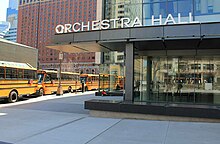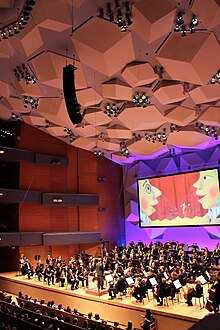Orchestra Hall (Minneapolis)
This article needs to be updated. (June 2017) |
 | |
| Address | 1111 Nicollet Mall |
|---|---|
| Location | Minneapolis, Minnesota |
| Coordinates | 44°58′20″N 93°16′30″W / 44.97222°N 93.27500°WCoordinates: 44°58′20″N 93°16′30″W / 44.97222°N 93.27500°W |
| Type | concert hall |
| Capacity | 2,087 |



Orchestra Hall, located on 11th Street at Peavey Plaza, between Nicollet Mall and Marquette Avenue in downtown Minneapolis, Minnesota, United States, is home to the Minnesota Orchestra. It is a major landmark of the southern portion of Nicollet Mall and home to many events throughout the year, in addition to being the Orchestra's home.
The auditorium seats 2,089,[1] of which about 1,200 are accommodated on the main floor. The remaining seats are placed in three balconies above and along the sides of the main floor. The auditorium is actually a second building separated for acoustical reasons by a one-inch gap from the "shell" which contains the lobby and various administrative offices. The stage contains an unusual feature: a large cube motif in the rear stage wall which continues along the ceiling towards the rear of the auditorium. The cubes were added for acoustic reasons, successfully, and turned out to be visually striking as well.[2]
History[]
The Hall was designed by Hammel, Green and Abrahamson and opened for the 1974 concert season.
Originally noted for its modernist design, chosen to represent an orchestra for everyone, not what was then perceived to be the formal "elitist" designs of the past.[2] The exterior of the building was recognizable by its large, blue ventilation ducts. Their unusual size was chosen to reduce air velocity and hence noise. The lobby area's original "power plant" design was meant to remove tones of class and privilege from the symphony-going experience; it was upgraded in late 1997 and included several bars.[2] Expansive windows overlooked the street.
Built in 1975, Peavey Plaza was designed by landscape architect M. Paul Friedberg who also designed the Loring Greenway. The plaza which holds an amphitheater and water fountain is considered one of the endangered historic properties in Minnesota.[3][4]
Renovation[]
In April 2007, it was announced that the hall would be undergoing a multimillion-dollar renovation.[5] This renovation had a heavy emphasis on the lobby and patron areas.
On April 9, 2010, plans were revealed for a $40 million renovation and expansion. The lobby and public areas were doubled in size and the former utilitarian exterior was replaced with stone and glass. A grand new entrance was also added. KPMB of Toronto were the architects and MBJ of Minneapolis were the structural engineers. Construction began in June 2012 and was completed in June 2013.[6]
See also[]
References[]
- ^ Royce, Graydon (September 12, 2013). "A first look at Minnesota Orchestra's $50 million remodeling project". Star Tribune. Star Tribune. Retrieved 2014-03-06.
- ^ a b c Millett, Larry (2007). AIA Guide to the Twin Cities: The Essential Source on the Architecture of Minneapolis and St. Paul. Minnesota Historical Society Press. p. 30. ISBN 978-0-87351-540-5.
- ^ Metzger, Michael (May 1, 2008). "Peavey Plaza makes list of endangered historic sites". MinnPost.com. MinnPost. Retrieved 2008-05-01.
- ^ Bruch, Michelle (May 1, 2008). "Peavey Plaza on list of endangered historic places". Downtown Journal. Minnesota Premier Publications. Retrieved 2008-05-01.
- ^ "What Sounds Great at Orchestra Hall? A $90m Facelift" St. Paul Pioneer Press, 30 April 2007.
- ^ "M. A. Mortenson Company – Orchestra Hall Renovation".
{{cite web}}: CS1 maint: url-status (link)
External links[]
- Concert halls in Minnesota
- Buildings and structures completed in 1974
- Buildings and structures in Minneapolis
- Music venues in Minnesota
- Tourist attractions in Minneapolis
- KPMB Architects buildings
